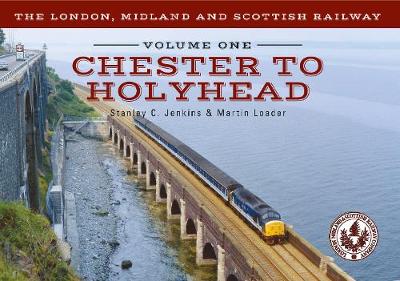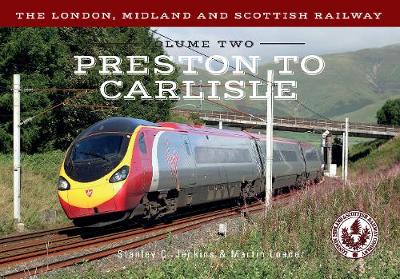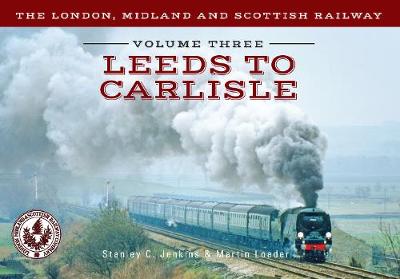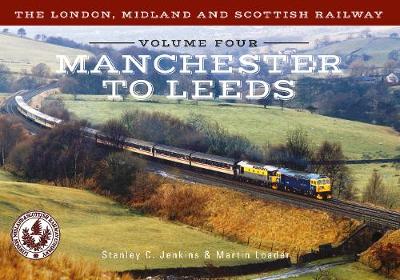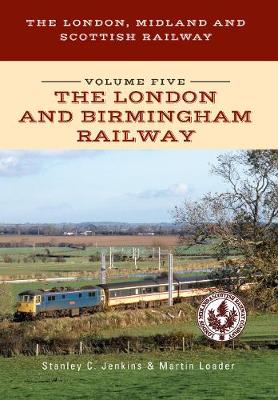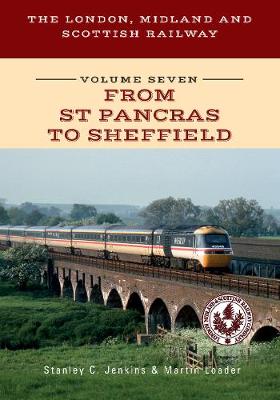The London, Midland and Scottish Railway
7 primary works
Book 1
The London, Midland and Scottish Railway Volume One Chester to Holyhead
by Stanley C. Jenkins and Martin Loader
Published 15 March 2015
The Chester & Holyhead Railway was incorporated by an Act of Parliament in 1844, and the promoters were thereby empowered to build an 85-mile line along the North Wales coast, the engineer for the line being Robert Stephenson. The C&HR was, from its inception, intended to form part of a rail link between London and Dublin - the assumption being that such a line would improve the economic position of Ireland, while at the same time binding it ever more closely to the rest of the United Kingdom.
In engineering terms, the C&HR presented huge challenges. The first 45 miles would follow an easy route alongside the Dee Estuary, but at Conwy the railway would have to cross a tidal river. The line would then be carried past the great towering headland at Penmaenmawr, while to the west of Bangor, the Menai Straits would have to be spanned by a bridge large enough to clear the masts of the largest vessels. The railway was completed by 1850 and, since that time, it has fulfilled its primary role as an artery of communication between England, Wales and Ireland.
In engineering terms, the C&HR presented huge challenges. The first 45 miles would follow an easy route alongside the Dee Estuary, but at Conwy the railway would have to cross a tidal river. The line would then be carried past the great towering headland at Penmaenmawr, while to the west of Bangor, the Menai Straits would have to be spanned by a bridge large enough to clear the masts of the largest vessels. The railway was completed by 1850 and, since that time, it has fulfilled its primary role as an artery of communication between England, Wales and Ireland.
Book 2
The London, Midland and Scottish Railway Volume Two Preston to Carlisle
by Stanley C. Jenkins and Martin Loader
Published 15 October 2015
The obvious success of the Liverpool & Manchester Railway demonstrated that steam railways were a safe, fast and efficient form of transport, and by the end of the 1830s ambitious entrepreneurs were planning a multiplicity of railways up, down and across the land. At first, the new railways were of purely local importance, but the need to connect important cities such as London, Birmingham, Manchester and Glasgow led to the promotion of major trunk routes, one of the first of these being the Lancaster & Carlisle Railway, which was authorised on 6 June 1844 as a northwards extension of the Lancaster & Preston Junction Railway.
In its original form the Lancaster & Preston line was little more than a branch, but the establishment of railway communication between London and Scotland was regarded as a matter of national importance, and the L&PJ and L&CR lines thereby became vital parts of the West Coast Main Line. Building work was soon under way, and this important main line was opened as far as Kendal on 21 September 1846 and completed throughout to Carlisle on 15 December. The new railway, which ran through difficult terrain on its way to Carlisle, was a major feat of civil engineering, and its bridges, viaducts and other infrastructure stand to this day as tangible monuments of the early days of railway construction.
In its original form the Lancaster & Preston line was little more than a branch, but the establishment of railway communication between London and Scotland was regarded as a matter of national importance, and the L&PJ and L&CR lines thereby became vital parts of the West Coast Main Line. Building work was soon under way, and this important main line was opened as far as Kendal on 21 September 1846 and completed throughout to Carlisle on 15 December. The new railway, which ran through difficult terrain on its way to Carlisle, was a major feat of civil engineering, and its bridges, viaducts and other infrastructure stand to this day as tangible monuments of the early days of railway construction.
Book 3
The London, Midland and Scottish Railway Volume Three Leeds to Carlisle
by Stanley C. Jenkins and Martin Loader
Published 15 January 2016
LEEDS to CARLISLE - The line from Leeds to Carlisle furnished the Midland Railway with an independent route to Scotland, in opposition to the rival London & North Western line. The railway extends for 113 miles, the easternmost sections having been constructed by the Leeds & Bradford and 'Little' North Western railways, while the spectacular northwards continuation from Settle to Carlisle was built by the Midland.
Opened in 1875, the Settle & Carlisle line was built at a relatively late date by an imperial nation at the height of its power, and the infrastructure exemplifies Victorian construction techniques at their most confident. There are no less than 25 viaducts, together with 85 overbridges, 130 underbridges and 13 tunnels - the massive arched viaducts having an imperial grandeur that echoes the splendours of ancient Rome. Although it has been threatened with closure at various times, the Settle & Carlisle route remains in operation as part of the national rail system, and it is now regarded as a tourist attraction in its own right.
Opened in 1875, the Settle & Carlisle line was built at a relatively late date by an imperial nation at the height of its power, and the infrastructure exemplifies Victorian construction techniques at their most confident. There are no less than 25 viaducts, together with 85 overbridges, 130 underbridges and 13 tunnels - the massive arched viaducts having an imperial grandeur that echoes the splendours of ancient Rome. Although it has been threatened with closure at various times, the Settle & Carlisle route remains in operation as part of the national rail system, and it is now regarded as a tourist attraction in its own right.
Book 4
The London, Midland and Scottish Railway Volume Four Manchester to Leeds
by Stanley C. Jenkins and Martin Loader
Published 15 September 2016
The Manchester & Leeds Railway was sanctioned by Parliament in 1836 as a railway commencing at Manchester and terminating at Normanton, from where trains would reach Leeds via the North Midland Railway. Although Leeds is only 35 miles from Manchester, the hilly nature of the surrounding terrain meant that the company engineers adopted a circuitous route through Rochdale, Todmorden, Hebden Bridge and the sinuous and steep-sided Calder Valley. The ‘Calder Valley’ line was opened between Manchester and Littleborough on 3 July 1839, and further sections were brought into use on 5 October 1840 and 3 January 1841. The railway was completed throughout on 1 March 1841.
The completed railway was heavily engineered, the Summit Tunnel between Littleborough and Walsden being the longest in the world at the time of its construction. This highly scenic line still forms part of an important rail link between Manchester and Leeds, although trains now travel on a shorter route via Halifax and Bradford. The eastern half of the route also forms part of separate Trans-Pennine route via Todmorden, Burnley and Blackburn.
The completed railway was heavily engineered, the Summit Tunnel between Littleborough and Walsden being the longest in the world at the time of its construction. This highly scenic line still forms part of an important rail link between Manchester and Leeds, although trains now travel on a shorter route via Halifax and Bradford. The eastern half of the route also forms part of separate Trans-Pennine route via Todmorden, Burnley and Blackburn.
Book 5
The London, Midland and Scottish Railway Volume Five The London and Birmingham Railway
by Stanley C. Jenkins and Martin Loader
Published 15 June 2017
Authorised on 8 May 1833, the London & Birmingham Railway was one of Britain's first great trunk lines. Engineered by Robert Stephenson (1803-1859), the L&BR line was regarded at the time of its construction as 'the Eighth Wonder of the World'. The route was opened in stages; the first section from Euston to Boxmoor was brought into use on 20 June 1837. The route was extended to Tring on 16 October 1837, and on 9 April 1838 further sections were opened from Tring to Denbigh Hall and between Rugby, Coventry and Birmingham. Finally, on 17 September 1838, the L&BR route was completed throughout its 112-mile length.
In its original form, the L&BR functioned as a transport link between London and Birmingham, but the establishment of long-distance railway communication between London and Scotland was regarded as a matter of national importance, and further companies such as the Grand Junction Railway and the Lancaster & Carlisle line were brought into existence to facilitate this ambitious aspiration. Although the L&BR was, at first, suspicious of these new companies, the London & Birmingham directors eventually decided to co-operate, and by 1846 the major west coast companies had amalgamated to form the 'London & North Western Railway' with the West Coast Main Line from Euston to Glasgow being one of the busiest railways in Britain, if not the world.
In its original form, the L&BR functioned as a transport link between London and Birmingham, but the establishment of long-distance railway communication between London and Scotland was regarded as a matter of national importance, and further companies such as the Grand Junction Railway and the Lancaster & Carlisle line were brought into existence to facilitate this ambitious aspiration. Although the L&BR was, at first, suspicious of these new companies, the London & Birmingham directors eventually decided to co-operate, and by 1846 the major west coast companies had amalgamated to form the 'London & North Western Railway' with the West Coast Main Line from Euston to Glasgow being one of the busiest railways in Britain, if not the world.
Book 6
The London, Midland and Scottish Railway Volume Six The Grand Junction and North Union Railways
by Stanley C. Jenkins and Martin Loader
Published 15 July 2017
Approved in May 1833 at the same time as the London & Birmingham Railway, the Grand Junction Railway was intended to act as a link between the London & Birmingham and the Liverpool & Manchester Railway. Built under the guidance of Joseph Locke, the Grand Junction was opened along its complete length on 4 July 1837. From 19 August 1839, through coaches were able to run for 218 miles from London through Birmingham to Preston. Preston had been connected to the railway network through the North Union Railway, which had been laid out by Irish engineer Charles Blacker Vignoles and opened to the public on 31 October 1838.
Brought into existence to facilitate the ambitious aspiration of long-distance railway communications between London and Scotland, these lines would be among those that amalgamated in 1846 to form the London & North Western Railway, the forerunner of today’s West Coast Main Line.
This book, the last in a six-part series, will examine these lines along with the Trent Valley Railway, all vital links in the network of railways that became the West Coast Main Line, one of the busiest railways in Britain, if not the world.
Brought into existence to facilitate the ambitious aspiration of long-distance railway communications between London and Scotland, these lines would be among those that amalgamated in 1846 to form the London & North Western Railway, the forerunner of today’s West Coast Main Line.
This book, the last in a six-part series, will examine these lines along with the Trent Valley Railway, all vital links in the network of railways that became the West Coast Main Line, one of the busiest railways in Britain, if not the world.
Book 7
The London, Midland and Scottish Railway Volume Seven From St Pancras to Sheffield
by Stanley C. Jenkins and Martin Loader
Published 15 September 2020
The Midland main line from London St Pancras to the north of England is one of Britain’s most important trunk routes. With its various loops and branches, this major artery of communication links busy centres of population such as Leicester, Derby, Nottingham, Sheffield, Manchester and Leeds. Notwithstanding its obvious importance as a busy main line, the Midland route was built in piecemeal fashion, the various sections (from London northwards) being the Midland Railway London Extension (opened 1868); the Leicester & Hitchen Railway (1857); the Midland Counties Railway (1840); and the North Midland Railway (1840).
In recent years the Midland line has been regarded primarily as a link between London and Sheffield, although a number of services have continued to run through to Leeds, Manchester and other destinations in the north of England. However, during the Midland Railway period the best trains had run northward beyond Leeds, and thence along the spectacular Settle & Carlisle route which, in turn, provided a direct link to Scotland via the Glasgow & South Western Railway. Prestigious Anglo-Scottish trains no longer run on the Midland main line, but this historic route remains in operation as a vital part of the national railway system.
In recent years the Midland line has been regarded primarily as a link between London and Sheffield, although a number of services have continued to run through to Leeds, Manchester and other destinations in the north of England. However, during the Midland Railway period the best trains had run northward beyond Leeds, and thence along the spectacular Settle & Carlisle route which, in turn, provided a direct link to Scotland via the Glasgow & South Western Railway. Prestigious Anglo-Scottish trains no longer run on the Midland main line, but this historic route remains in operation as a vital part of the national railway system.
